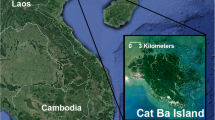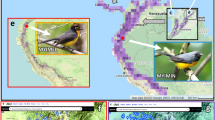Abstract
According to ecological theory, the concept of niche differentiation is essential to our understanding of how sympatric species can limit competition over resources. We here examine ecological niche differentiation in 2 sympatric Asian langurs, Presbytis potenziani and Simias concolor, both endemic to the Mentawai Islands off the west coast of Sumatra. We collected data (home range size, canopy use, activity budgets, diet, and niche breadth and overlap) using GPS and scan/focal animal sampling methods on 2 groups of Presbytis potenziani and 3 groups of Simias concolor living in a mixed primary rain forest in northern Siberut. Results show that home ranges of the 2 species overlapped completely and that the home range size of Presbytis potenziani was ca. 4 times larger than that of Simias concolor. Lower canopy levels (<20 m) were used more often by Simias concolor, whereas Presbytis potenziani preferred the canopy >20 m. Apart from foraging and other activities, there was little difference in overall activity budgets of the 2 species. Regarding diet, although 60% of all food species examined were used by both langur species, they shared only 3 of the 10 most commonly eaten species. Presbytis potenziani fed more selectively on fruits, whereas Simias concolor fed predominantly on leaves. Levin’s niche breadth indices revealed that the diet of Simias concolor is more general (0.34) than that of Presbytis potenziani (0.22). Based on a Pianka index of 0.32, we conclude that there is a relatively small food niche overlap between the 2 colobine species and that diet represents an important mechanism enabling their coexistence.



Similar content being viewed by others
References
Agostini, I., Holzman, I., & Bitetti, M. S. (2010). Are howler monkey species ecologically equivalent? Trophic niche overlap in syntopic Alouatta quariba clamitans and Alouatta caraya. American Journal of Primatology, 72, 173–186.
Ankel-Simons, F. (2000). Primate anatomy. San Diego: Academic Press.
Bennett, E. L., & Sebastian, A. C. (1988). Social organization and ecology of the proboscis monkey N. larvatus in mixed coastal forest in Sarawak. International Journal of Primatology, 9, 233–255.
Bennett, E. L., & Davies, A. G. (1994). The ecology of Asian colobines. In A. G. Davies & J. F. Oates (Eds.), Colobine monkeys: Their ecology, behaviour and evolution (pp. 129–171). Cambridge, UK: Cambridge University Press.
Boyle, S. A., Lourenço, W. C., da Silva, L. R., & Smith, A. T. (2009). Home range estimates vary with sample size and methods. Folia Primatologica, 80, 33–42.
Brotoisworo, E., & Dirgayusa, I. W. A. (1991). Ranging and feeding behaviour of Presbytis cristata in the Pangandaran Nature Reserve, West Java, Indonesia. In A. Ehara, T. Kimura, O. Takenaka, & M. Iwamonto (Eds.), Primatology Today.
Caton, J. M. (1998). The morphology of the gastrointestinal tract of Pygathrix nemaeus (Linneaus, 1771). In N. G. Jablonski (Ed.), The natural history of douc and snub-nosed monkeys (pp. 129–152). London: World Scientific.
Chapman, C. A., & Pavelka, M. S. M. (2005). Group size in folivorous primates: ecological constraints and the possible influence of social factors. Primates, 46, 1–9.
Chapman, C. A., Struhsaker, T. T., Skorupa, J. P., Snaith, T. V., & Rothman, J. M. (2010). Understanding long-term primate community dynamics: implications of forest change. Ecological Applications, 20, 179–191.
Colwell, R. K., & Futuyma, D. J. (1971). On the measurement of niche breadth and overlap. Ecology, 52, 567–576.
Curtin, S. H. (1976). Niche separation in sympatric Malaysian leaf-monkeys (Presbytis obscurus and Presbytis melalophos). Yearbook of Physical Anthropology, 20, 421–439.
Curtin, S. H. (1980). Dusky and banded leaf monkeys. In D. J. Chiver (Ed.), Malayan forest primates (pp. 107–145). New York: Plenum Press.
Davies, A. G. (1984). Ecological study of the red leaf monkey (Presbytis rubicunda) in the Dipterocarpus Forest of northern Borneo. Ph.D. dissertation, University of Cambridge.
Davies, A. G. (1991). Seed-eating by red leaf monkeys (Presbytis rubicunda) in dipterocarp forest of northern Borneo. Interantional Journal of Primatology, 12, 119–144.
Davies, A. G., Bennett, E. L., & Waterman, P. G. (1988). Food selection by two south-east Asian colobine monkeys (Presbytis rubicunda and Presbytis melalophos) in relation to plant chemistry. Biological Journal of the Linnean Society, 34, 33–56.
Eckardt, W., & Zuberbühler, K. (2004). Cooperation and competition in two forest monkeys. Behavioral Ecology, 15, 400–411.
Fleagle, J. (1977). Locomotor behavior and muscular anatomy of sympatric Malaysian leaf monkeys Presbytis obscura and Presbytis melalophos. American Journal of Physical Anthropology, 46, 297–308.
Folk, D. (2000). Primate diversity (pp. 178–197). New York: W. W. Norton.
Fuentes, A. (1994). The socioecology of the Mentawai Island langur (Presbytis potenziani). Dissertation (pp. 12–94). University of California, Berkeley.
Fuentes, A. (1996). Feeding and ranging in the Mentawai Island langur (Presbytis potenziani). International Journal of Primatology, 17, 525–548.
Ganzhorn, J. U. (1989). Niche separation of seven lemur species in the eastern rainforest of Madagascar. Oecologia, 79, 279–286.
Gause, G. F. (1934). The struggle for existence. New York: Hafner.
Gurmaya, K. J. (1994). Ecology and behaviour of Presbytis thomasi in northern of Sumatra. Primates, 27, 151–172.
Hadi, S., Ziegler, T., & Hodges, J. K. (2009a). Group structure and physical characteristics of Simakobu monkeys (Simias concolor) on the Mentawai Island of Siberut, Indonesia. Folia Primatologica, 80, 74–82.
Hadi, S., Ziegler, T., Waltert, M., & Hodges, J. K. (2009b). Tree diversity and forest structure in northern Siberut, Mentawai islands, Indonesia. Tropical Ecology, 50, 315–327.
Heymann, E. W., & Buchanan-Smith, H. M. (2000). The behavioural ecology of mixed-species troops of callitrichine primates. Biological Reviews, 75, 169–190.
Heymann, E. W., Knogge, C., & Herrera, E. R. T. (2000). Vertebrate predation by sympatric tamarins, Saguinus mystax and Saguinus fuscicollis. American Journal of Primatology, 51, 153–158.
Hladik, C. M. (1977). A comparative study of the feeding strategies of two sympatric species of leaf monkeys: Presbytis senenx and Presbytis entellus. In T. E. Clutton-Brock (Ed.), Primate ecology: Studies of feeding and ranging behavior in lemurs, monkeys, and apes (pp. 324–353). London: Academic Press.
Houle, A., Vickery, W. L., & Chapman, C. A. (2006). Testing mechanisms of coexistence among two species of frugivorous primates. Journal of Animal Ecology, 75, 1034–1044.
Hutchinson, G. E. (1957). Concluding remarks. Cold Spring Harbour Symposia on Quantitative Biology, 22, 415–427.
Islam, M. A., & Husain, K. Z. (1982). A prelimainary study on the ecology of capped langur. Folia Primatologica, 39, 145–159.
Kuhn, H. J. (1964). Zur Kenntnis von Bau und Funktion des Magen der Schlankaffen. Folia Primatologica, 2, 193–221.
Levins, R. (1968). Evolution in changing environment. Princeton, NJ: Princeton University Press.
Li, Z., & Rogers, E. (2004). Habitat quality and activity budgets of white-headed langurs in Fusui, China. International Journal of Primatology, 25, 41–54.
Matsuda, I., Tuuga, A., & Higashi, S. (2009). The feeding ecology and activity budget of proboscis monkeys. American Journal of Primatology, 71, 478–492.
Medway, L. (1970). The monkey of Sundaland: Ecology and systematic of the Cercopithecids of a humid equatorial environment. In N. H. Napier (Ed.), Old world monkeys: Evolution, systematic and behaviour (pp. 513–554). New York: Academic Press.
Mitani, M. (1991). Present situation of primate fauna found in northern Congo and in southeastern Cameroon in the central Africa. Primatology Today, 43–46.
Mitchell, A. H. (1994). Ecology of Hose’s langur, Presbytis hosei, in mixed logged and unlogged dipterocarp forest of north Borneo. Ph.D. thesis, Yale University.
Napier, P. H. (1985). Cataloque of primates in the British Museum (Natural History) and elsewhere in the British Isles, Part III (pp. 88–91). London: British Museum.
Oates, J. F., & Davies, A. G. (1994). What are the colobines? In A. G. Davies & J. F. Oates (Eds.), Colobine monkeys: Their ecology, behaviour and evolution (pp. 1–9). Cambridge, UK: Cambridge University Press.
Pianka, E. R. (1973). The structure of lizard communities. Annual Review of Ecology and Systematics, 4, 53–74.
Redmond, I. (2008). Primates of the world: The amazing diversity of our closest relatives (pp. 132–143). London: New Holland.
Reed, K. E., & Bidner, L. R. (2004). Primate communities: past, present and possible future. Yearbook of Physical Anthropology, 47, 2–39.
Rowe, N. (1996). The pictorial guide to the living primates. New York: Pogonias Press.
Ruhiyat, Y. (1983). Socioecological study of Presbytis aygula in West Java. Primates, 24, 334–359.
Sangchantr, S. (2004). Social organization and ecology of Mentawai leaf monkeys (Presbytis potenzani). Ph.D. thesis, Columbia University.
Schoener, T. W. (1974). Resource partitioning in ecological communities. Science, 185, 27–39.
Singh, M. R., Singh, M. E., Ananda, K. M., Kumara, H. N., Sharma, A. K., & Sushma, H. S. (2000). Niche separation in sympatric lion-tailed macaque (Macaca silenus) and nilgiri langur (Presbytis johnii) in an Indian tropical rain forest. Primate Report, 58, 83–95.
Singh, M., Royi, K., & Singg, M. (2011). Resource partitioning in sympatric langurs and macaques in tropical rainforests of the central Western Ghats, South India. American Journal of Primatology, 73, 335–346.
Struhsaker, T. T., & Oates, J. F. (1975). Comparison of behaviour and ecology of red colobus and black-and-white colobus monkeys in Uganda: A summary. In R. H. Tuttle (Ed.), Socioecology and physiology of primates (pp. 103–123). The Hague: Mouton.
Sushma, H. S., & Singh, M. (2006). Resource partitioning and interspecific interactions among sympatric rainforest arboreal mammals of the Western Ghats, India. Behavioural Ecology, 17, 479–490.
Tenaza, R. R. (1987). The status of primates and their habitats in the Pagai Island, Indonesia. Primate Conservation, 8, 104–110.
Tenaza, R. R., & Fuentes, A. (1995). Monandrous social organization of pig-tailed langurs (Simias concolor) in the Pagai Islands, Indonesia. International Journal of Primatology, 16, 295–310.
Tilson, R. L. (1977). Social organization of Simakobu monkeys (Nasalis concolor) in Siberut Island, Indonesia. Journal of Mammalogy, 58, 202–212.
Tilson, R. L., & Tenaza, R. R. (1982). Interspecific spacing between gibbons (Hylobates klossii) and langurs (Presbytis potenziani) on Siberut Island, Indonesia. American Journal of Primatology, 2, 355–361.
Tokeshi, M. (1999). Species coexistence: Ecological and evolutionary perspectives. Oxford: Blackwell Science.
Vasey, N. (2000). Niche separation in Varecia variegata rubra and Eulemur fulfus albifrons: I. Interspecific pattern. American Journal of Physical Anthropology, 112, 411–431.
Watanabe, K. (1981). Variations in group composition and population density of the two sympatric Mentawaian leaf-monkeys. Primates, 22, 145–160.
White, E. J., Dikangadisi, J. T., Dimoto, E., Karesh, W. B., Knock, M. D., Abiaga, N. O., Starkey, R., Ukizintambara, T., White, L. J. T., & Abernethy, K. A. (2010). Home-range use by a large horde of wild Mandrillus spinx. International Journal of Primatology, 31, 627–645.
Yeager, C. P. (1993). Ecological constraints on the intergroup associations in the proboscis monkey Nasalis larvatus. Tropical Biodiversity, 1, 89–100.
Acknowledgments
This project was conducted as part of the Siberut Conservation Programme (SCP). We thank SCP field assistants Rahmah T. Rahayu, Dwi Y. Febriyanti, Ratna Wulandari, Yohanes Wibisono, Vera Ikawati, Yulia D. Handayani, and Taswirul Afiyatin for their support during data collection. We also thank the SCP field manager Dodi Priata and secretary Siti Aminah for field and logistic support. We are much obliged to the chief of Policoman village, Marholop Salakkomak, for permission to conduct long-term field studies in the aboriginal communal forest of Peleonan. We especially thank Mohammad Agil from Bogor Agricultural University (IPB) for administrative support and Sara Bauer from the Institut für Waldbiologie und Jagdkunde, University of Göttingen, for her assistance with kernel analysis. We also thank the Prince Albert II of Monaco Foundation for partial funding of the project and Idea Wild for providing items of fieldwork equipment. Finally, we thank the 3 anonymous reviewers and the associate editor for providing valuable comments on the manuscript.
Author information
Authors and Affiliations
Corresponding author
Electronic supplementary material
Below is the link to the electronic supplementary material.
ESM 1
(DOC 226 kb)
Rights and permissions
About this article
Cite this article
Hadi, S., Ziegler, T., Waltert, M. et al. Habitat Use and Trophic Niche Overlap of Two Sympatric Colobines, Presbytis potenziani and Simias concolor, on Siberut Island, Indonesia. Int J Primatol 33, 218–232 (2012). https://doi.org/10.1007/s10764-011-9567-y
Received:
Accepted:
Published:
Issue Date:
DOI: https://doi.org/10.1007/s10764-011-9567-y




